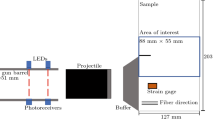Abstract
The double cleavage drilled compression (DCDC) test was used to measure the critical energy release rate, moisture-assisted crack growth, and fatigue threshold for epoxy–glass interfaces bonded with and without a silane coupling agent. The DCDC specimen consists of two glass beams (either soda-lime or fused silica) bonded together with an epoxy adhesive. A through-the-thickness hole is drilled in the centre of the specimen. In the DCDC test compressive loading causes tensile stresses to develop at the poles of the drilled hole. Cracks then nucleate in the epoxy–glass interface, extend from the poles, and propagate axially along the interface in primarily mode I loading. The resistance to moisture-assisted crack growth at untreated epoxy–glass interfaces is significantly less than that in monolithic glass specimens. However, the resistance to moisture-assisted crack growth at silane bonded epoxy–glass interfaces can be comparable with or greater than that in monolithic glass. Silane bonding of epoxy to glass is more effective with fused silica than soda-lime glass, with the fatigue limit of silane bonded epoxy–fused silica interfaces being about 2.5 times greater than that for silane bonded epoxy–soda-lime glass. These results are discussed in terms of possible interfacial crack growth mechanisms. © 1998 Kluwer Academic Publishers
Similar content being viewed by others
References
S. Wu, “Polymer interface and adhesion” (Marcel Dekker, New York, 1982).
A. J. Kinloch, “Adhesion and adhesives: science and technology” (Chapman and Hall, London, 1987).
E. P. Plueddemann, “Silane coupling agents”, 2nd Edn (Plenum Press, New York, 1991).
A. J. Kinloch, Preprint No. 08, Proceedings of the Institution of Mechanical Engineers, London, 1996.
R. Lin, H. Wang, D. S. Kaleka and L. S. Penn, J. Adhesion Sci. Technol. 10(4) (1996) 327.
R. Lin, R. P. Quick, J. Kuang and L. S. Penn, ibid. 10(4) (1996) 341.
M. R. Turner, B. J. Dalgleish, M. Yitte and A. G. Evans, Acta Metall. Mater. 43 (1995) 3459.
M. Y. He, M. R. Turner and A. G. Evans, ibid. 43 (1995) 3453.
J. E. Ritter, T. J. Lardner, A. J. Stewart and G. C. Prakash, J. Adhesion 49 (1995) 97.
Z. Suo and J. W. Hutchinson, Mater. Sci. Enging A107 (1989) 135.
C. Janssen, in Proceedings of the Tenth International Congress on Glass, Kyoto, Japan, July, 1974 (The Ceramic Society of Japan, Kyoto, Japan, 1974) pp. 23–30.
W. H. Smith, Closed Loop Magazine Spring (1987) 18.
J. D. Helfinstine, S. T. Gulati and D. G. Pikles, in “The Physics of Non-Crystaline Solids”, edited by L. D. Pye, W. C. LaCourse and H. J. Stevens (Taylor and Francis, Bristol, PA, 1992) pp. 654–8.
S. W. Wiederhorn, J. Amer. Ceram. Soc. 50(8) (1969) 407.
S. M. Wiederhorn and L. H. Bolz, ibid. 53(10) (1970) 543.
J. E. Ritter, T. J. Lardner, W. Grayeski, G. C. Prakash and J. Lawrence, J. Adhesion 63 (1997) 265.
R. K. Iler, “The chemistry of silica” (Wiley, New York, 1975).
T. A. Michalske and S. W. Freiman, J. Amer. Ceram. Soc. 66 (1953) 284.
C. G. Patano, D. B. Dove and G. Y. Onoda, J. Vac. Sci. Technol. 13 (1) (1976) 414.
T. A. Michalske and E. R. Fuller Jr, J. Amer. Ceram. Soc. 68 (11) (1985) 586.
M.-Y. He and J. W. Hutchinson, Int. J. Solids Structures 25 (9) (1989) 1053.
R. H. Doremus, “Glass science” (Wiley, New York, 1973).
Author information
Authors and Affiliations
Rights and permissions
About this article
Cite this article
Ritter, J.E., Fox, J.R., Hutko, D.I. et al. Moisture-assisted crack growth at epoxy–glass interfaces. Journal of Materials Science 33, 4581–4588 (1998). https://doi.org/10.1023/A:1004477006957
Issue Date:
DOI: https://doi.org/10.1023/A:1004477006957




